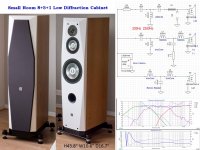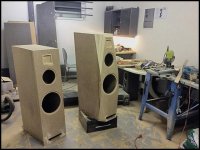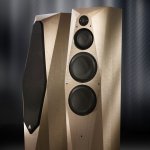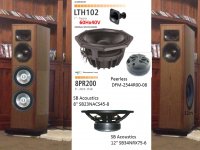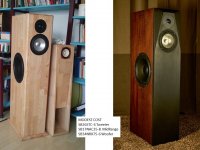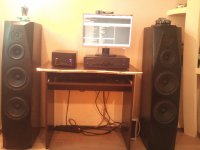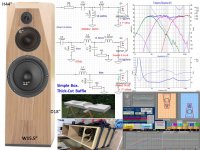Thanks Cider, SP44 might suit your needs. Drive units only would cost you $1,600. A quote from Madisound on midrange unit Accuton C50-8-044:
"Discontinued, last remaining stock. Once this stock is sold, Accuton will supply replacement units for a short period for existing customers who own a damaged driver. Contact us to arrange for purchase of replacements if your requirements exceed our current stock."
"Discontinued, last remaining stock. Once this stock is sold, Accuton will supply replacement units for a short period for existing customers who own a damaged driver. Contact us to arrange for purchase of replacements if your requirements exceed our current stock."
Last edited:
SIDEBAR___ If you plan to build several speakers in the future, DSP + multiple amplifiers is the best investment.
--The FUTURE is NOW.
You can use your PC software + a multiple output sound card, or purchase MiniDSP type hardware.
_______________________
Citer,
An "Avalon style" cabinet with large edge bevels will significantly reduce distortion from edge diffraction.
A 10"-12" wide cabinet will support one or two PORTED 8" woofer which can produce powerful deep bass -F3 ~30Hz.
A 15" wide cabinet will support a SEALED 12" woofer with excellent transient response -F3 ~36Hz.
There are at least 10 DIY Avalon style cabinet clones on the internet. International designs from: America, Germany, Poland, Denmark, Korea, India. DIY designs with one 8" or 10" or 12" front woofer. Larger designs which copy Avalon products with two 8" or 10" or 12" front woofers.
Most listeners favor the tigher, more controlled transients from a sealed woofer vs. a ported woofer. There are a few diy- Avalon style front baffles with the tweeter + sealed midrange, plus a side baffle woofer which have appeared. 11" wide front baffle + 16" deep side baffle.
DECIDE on a cabinet size and the diyAudio forum will help you find designs to build.
--The FUTURE is NOW.
You can use your PC software + a multiple output sound card, or purchase MiniDSP type hardware.
_______________________
Citer,
An "Avalon style" cabinet with large edge bevels will significantly reduce distortion from edge diffraction.
A 10"-12" wide cabinet will support one or two PORTED 8" woofer which can produce powerful deep bass -F3 ~30Hz.
A 15" wide cabinet will support a SEALED 12" woofer with excellent transient response -F3 ~36Hz.
There are at least 10 DIY Avalon style cabinet clones on the internet. International designs from: America, Germany, Poland, Denmark, Korea, India. DIY designs with one 8" or 10" or 12" front woofer. Larger designs which copy Avalon products with two 8" or 10" or 12" front woofers.
Most listeners favor the tigher, more controlled transients from a sealed woofer vs. a ported woofer. There are a few diy- Avalon style front baffles with the tweeter + sealed midrange, plus a side baffle woofer which have appeared. 11" wide front baffle + 16" deep side baffle.
DECIDE on a cabinet size and the diyAudio forum will help you find designs to build.
Attachments
The latest Avalon Compas has a VERY ARTISTIC new top bevel design. The slanted baffle creates an equal time delay for the physical shallow tweeter and the physical deep midrange AT ONE listening distance. Typically a passive -LR2 crossover circuit with -90 degree phase shift is used on the tweeter, and a passive +LR2 circuit with +90 degree phase shift is used on the midrange... so they cancel out around the crossover frequency.
I would copy the Compas top bevels on a vertical baffle and use DSP for time delay, OR use steeper slope crossovers like BW3 on the tweeter and LR4 on the midrange to shift the phase=delay between tweeter and midrange around the crossover frequency. You can always put a wooden sloped wedge under the front of a vertical baffle speaker to physically delay the tweeter.
=========
=========
Has anyone sketched a few (Source + DSP + Ampliifers + Speakers + wires + BlueTooth) layout options they can share?
Real world:
--High quality 3 or 4 way sound from DSP crossover + room equalization
--It must be simple to move any speaker 10 feet around the room
--It must simple to DSP connect a different set of speakers
--It would be nice to allow flexible PC placement between rooms
--It would be nice if a powerful PC could simultaneously BlueTooth drive a second set of speakers
my.... OLD SCHOOL INTERCONNECT:
1) PC runs EXTENSIVE crossover and ROOM EQUALIZATION SW and outputs three low level analog signals to the power amps located NEAR(10' coaxial cables) to the PC. One analog output can easily Y-cable drive both intputs to two identical woofer amplifier channels
2) For each channel, three or four long 12-gauge wires go to each speaker (T, M, W or W+W)
3) Advantages:
-Powerful PC with single powerful wireless control for most functions
-Use old power amplifiers with enough power for each individual driver
-Easy to move each speaker 10 feet around the soundstage.
4) BlueTooth card(s) can be added to a powerful PC to drive second/third set of simple passive crossover speakers from the same music database
5) DisAdvantage
-Music PC must be within 30 feet of speakers(10 feet coaxials + 20 feet AWG-12 copper wire)
-Very visible 12-gauge wires
-No music without powerful PC (or maybe dedicated Linux computer)
I would copy the Compas top bevels on a vertical baffle and use DSP for time delay, OR use steeper slope crossovers like BW3 on the tweeter and LR4 on the midrange to shift the phase=delay between tweeter and midrange around the crossover frequency. You can always put a wooden sloped wedge under the front of a vertical baffle speaker to physically delay the tweeter.
=========
=========
Has anyone sketched a few (Source + DSP + Ampliifers + Speakers + wires + BlueTooth) layout options they can share?
Real world:
--High quality 3 or 4 way sound from DSP crossover + room equalization
--It must be simple to move any speaker 10 feet around the room
--It must simple to DSP connect a different set of speakers
--It would be nice to allow flexible PC placement between rooms
--It would be nice if a powerful PC could simultaneously BlueTooth drive a second set of speakers
my.... OLD SCHOOL INTERCONNECT:
1) PC runs EXTENSIVE crossover and ROOM EQUALIZATION SW and outputs three low level analog signals to the power amps located NEAR(10' coaxial cables) to the PC. One analog output can easily Y-cable drive both intputs to two identical woofer amplifier channels
2) For each channel, three or four long 12-gauge wires go to each speaker (T, M, W or W+W)
3) Advantages:
-Powerful PC with single powerful wireless control for most functions
-Use old power amplifiers with enough power for each individual driver
-Easy to move each speaker 10 feet around the soundstage.
4) BlueTooth card(s) can be added to a powerful PC to drive second/third set of simple passive crossover speakers from the same music database
5) DisAdvantage
-Music PC must be within 30 feet of speakers(10 feet coaxials + 20 feet AWG-12 copper wire)
-Very visible 12-gauge wires
-No music without powerful PC (or maybe dedicated Linux computer)
Attachments
While I appreciate active crossovers from a technical standpoint, I'm not very excited about yet another pc and more complicated wiring. I do really like the look of those Avalons, though. I located a couple Accuton C50-8-044 that I could use for a pair of SP44s...
Obviously I shouldn't quit my day job, but I tried to represent the room where I listen. I drew in 216mm wide x 280mm deep x 990mm high speakers.
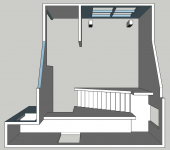
Obviously I shouldn't quit my day job, but I tried to represent the room where I listen. I drew in 216mm wide x 280mm deep x 990mm high speakers.

38" H x 8" W x 10" D is not smaller in terms of my impressions, and there are many designs that fit this size criteria.
As a size reference, my 20 ltr cabs will be 29" x 6" x 8" inside dims, so 30.5" x 7.5" x 9.5" external, plus a couple inches deeper to add in bracing, etc.
This project will be a quick cabinet construction, and the modeled xovers are almost assembled to do a trial run when I get the cabs together.
Like I said though- there are likely quite a few that meet your dimensional requirements. My pending project is just mentioned for relation of size.
Later,
Wolf
As a size reference, my 20 ltr cabs will be 29" x 6" x 8" inside dims, so 30.5" x 7.5" x 9.5" external, plus a couple inches deeper to add in bracing, etc.
This project will be a quick cabinet construction, and the modeled xovers are almost assembled to do a trial run when I get the cabs together.
Like I said though- there are likely quite a few that meet your dimensional requirements. My pending project is just mentioned for relation of size.
Later,
Wolf
That sounds super-compact. I assume it's meant to go on small stands?
I kind of want to try a 3-way, just to do something new (I've built two 2-way kits), but I want a slim front baffle--I think 9" is probably my limit. I also enjoy decent bass extension, although I don't listen real loud. Not sure how compatible those wishes are, but they are wishes .
.
Are any of your designs in that ballpark? I also saw rumors of an AE woofer for the Spirit Wind, but not sure if that's still under consideration or how big it would end up.
I kind of want to try a 3-way, just to do something new (I've built two 2-way kits), but I want a slim front baffle--I think 9" is probably my limit. I also enjoy decent bass extension, although I don't listen real loud. Not sure how compatible those wishes are, but they are wishes
Are any of your designs in that ballpark? I also saw rumors of an AE woofer for the Spirit Wind, but not sure if that's still under consideration or how big it would end up.
Actually, it's not meant for stands, but for optimized upward tilt angle. They'll extend to 45Hz vented using a pair of 5.25", and will be a TMM with ~86dB sensitivity. Output should be up to about 105dB before any issues become evident.
I don't currently have any 3-ways of the past that will fit that footprint. Maybe one of the ones in the idea stage will hit that mark in the future.
As to the AE woofer, Jeff B. would be the person to ask about a Spirit Wind alteration.
Later,
Wolf
I don't currently have any 3-ways of the past that will fit that footprint. Maybe one of the ones in the idea stage will hit that mark in the future.
As to the AE woofer, Jeff B. would be the person to ask about a Spirit Wind alteration.
Later,
Wolf
I kind of want to try a 3-way, but I want a slim front baffle--I think 9" is probably my limit. I also enjoy decent bass extension, although I don't listen real loud.
Thanks to room CAD tools "you pay's your money and you take's your chances" is no longer the necessary path to audio nirvina
I took your room floor plan and overlayed a few different speaker directivity plots.
a) a tweeter horn with 60-degree horizontal and 40-degree vertical directivity will give your the best soundstage by removing early wall reflections.
b) a cabinet 15" - 17" deep enough for a 12" side woofer easily fits your room layout.
c) you should maintain at least 3 feet of open space between your couch(listener) and your rear wall
=======
9" wide front baffle supports a sealed 6.5" midrange and a 12" sealed woofer on the 16" - 17" deep side panel.
=========
10" - 11" wide front baffle supports a sealed 6.5" midrange plus two 8" ported woofers...
10" - 11" wide front baffle supports a horn tweeter to significantly reduce wall reflections in your narrow room + sealed 8" midbass
--------option for either ported two 8" front baffle woofers or sealed one 12" side woofer
15" wide front baffle supports sealed 6.5" midrange plus 12" sealed woofer
Attachments
Last edited:
It would be fun to build some big speakers, but sadly I think a 15" baffle is just not going to work for me. I thought a little about your option (b) though, and I've been playing around with the Kairos 3-way to see if I can minimize the visual bulk (my existing speaker cabinet on the far left for reference):
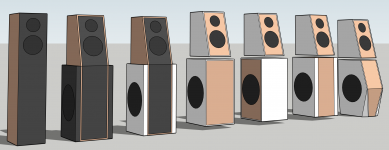

Why I suggested a controlled directivity horn tweeter.
========= CONTROLLED DIRECTIVITY ====
When loudspeakers interact with room boundaries and other acoustically reflective surfaces, the delay between direct and reflected sound waves affects not only the perceived timbre, but also the degree to which believable phantom stereo images are created. If reflected sound waves arrive too soon after the direct sound, they generate spurious directional cues that can spoil the stereo-imaging illusion. The precedence effect offers a remedy for the effect of room reflections on stereo imaging to the extent that the reflected sound is a sufficiently delayed copy of the direct sound, with similar spectral and temporal content, the auditory system will take directional cues only from the direct sound. To make this work we need loudspeakers with frequency-independent polar response (constant directivity) and we need to place them far enough from reflecting surfaces. Toole's research suggests that in a “typical” room, a delay of at least 5ms = 68in will put reflection levels below the threshold where they can be perceived as a second image
-----------
WIKI
"The on axis, free space directivity factor for sound sources with several common free space radiation patterns are as follows: Monopole: DF = 1.0, Dipole: DF = 3, Cardioid: DF = 3, 90x90 Horn: DF=8.27. What this means is that if these three different sources are to radiate the same total acoustic power, then if the monopole has an on axis intensity of 1.0 the dipole and cardioid will have an on axis intensity of 3.0 or 4.77 dB greater, and the horn will have an on axis intensity of 8.27 or 9.2 dB greater. Conversely, if the different sources are to have the same on axis intensity then the dipole and cardioid will radiate 1/3 the acoustic power of the monopole, and the horn 1/9 the acoustic power of the monopole. When studying room acoustics and reverberation this means that the "critical distance" from the speaker will be greater for a dipole or cardioid or horn than for a monopole. The "critical distance" is the distance at which direct and reflected sound are equal. The level of the reflected sound, above the modal region of the room, is usually considered constant and proportional to the total radiated power. Thus when sitting the same distance from a conventional speaker and a dipole/horn, the dipole/horn can potentially sound more detailed since at the position that ratio of direct to reflected sound is greater. "
--------
Both dipoles and horn designs control directivity to reduce early reflections from hard walls and floors. Draw your room floorplan and overlay Left+Right horn 90-degree and 60-degree horizontal polar patterns directed to the listener to see if early wall reflections can be significantly reduced. A tweeter horn with a 40-degree vertical polar pattern will reduce early reflections off your hard floor and low ceiling.
=========
========= CONTROLLED DIRECTIVITY ====
When loudspeakers interact with room boundaries and other acoustically reflective surfaces, the delay between direct and reflected sound waves affects not only the perceived timbre, but also the degree to which believable phantom stereo images are created. If reflected sound waves arrive too soon after the direct sound, they generate spurious directional cues that can spoil the stereo-imaging illusion. The precedence effect offers a remedy for the effect of room reflections on stereo imaging to the extent that the reflected sound is a sufficiently delayed copy of the direct sound, with similar spectral and temporal content, the auditory system will take directional cues only from the direct sound. To make this work we need loudspeakers with frequency-independent polar response (constant directivity) and we need to place them far enough from reflecting surfaces. Toole's research suggests that in a “typical” room, a delay of at least 5ms = 68in will put reflection levels below the threshold where they can be perceived as a second image
-----------
WIKI
"The on axis, free space directivity factor for sound sources with several common free space radiation patterns are as follows: Monopole: DF = 1.0, Dipole: DF = 3, Cardioid: DF = 3, 90x90 Horn: DF=8.27. What this means is that if these three different sources are to radiate the same total acoustic power, then if the monopole has an on axis intensity of 1.0 the dipole and cardioid will have an on axis intensity of 3.0 or 4.77 dB greater, and the horn will have an on axis intensity of 8.27 or 9.2 dB greater. Conversely, if the different sources are to have the same on axis intensity then the dipole and cardioid will radiate 1/3 the acoustic power of the monopole, and the horn 1/9 the acoustic power of the monopole. When studying room acoustics and reverberation this means that the "critical distance" from the speaker will be greater for a dipole or cardioid or horn than for a monopole. The "critical distance" is the distance at which direct and reflected sound are equal. The level of the reflected sound, above the modal region of the room, is usually considered constant and proportional to the total radiated power. Thus when sitting the same distance from a conventional speaker and a dipole/horn, the dipole/horn can potentially sound more detailed since at the position that ratio of direct to reflected sound is greater. "
--------
Both dipoles and horn designs control directivity to reduce early reflections from hard walls and floors. Draw your room floorplan and overlay Left+Right horn 90-degree and 60-degree horizontal polar patterns directed to the listener to see if early wall reflections can be significantly reduced. A tweeter horn with a 40-degree vertical polar pattern will reduce early reflections off your hard floor and low ceiling.
=========
I’m curious, how high can the side-firing woofer be crossed? Is it basically omnidirectional at 250 Hz (4.5 ft.).
Measurements and listening tests support that a Center-to-Center separation of less than "one quarter-wavelength distance @ crossover frequency" will mimic a point source coherence. So, a midrange-woofer crossover of under 170Hz = 80" wavelength allow a C-to-C spacing under 20" for quarter wavelength point source coherence, even to side placement.
Woofers located near the floor benefit from floor gain, and woofers below one-quarter the ceiling height reduce room mode effects. So, locate the woofer as close to the floor as the mid-woof quarter-wavelength spacing allows. The loss of point souce coherence is slow up to about one half wavelength distance, so some attention to floor bass gain and room bass resonance tuning is acceptable.
=====
The Kairos was designed as a PORTED construction to obtain deep bass while accepting modest compromises to the midrange transient performance and midrange clarity. A three way design supports a SEALED midrange construction which allows fast transients by selecting volumes producing Qtc = 0.57 to Qtc = 0.6 alignments. If you decide to seal a Kairos speaker, you will get a good Qtc= 0.75 alignment.
For a sealed midrange design, it is common to select midrange drivers with lower moving mass, stronger magnets, and lighter cones than what is selected for a ported design.
- Status
- This old topic is closed. If you want to reopen this topic, contact a moderator using the "Report Post" button.
- Home
- Loudspeakers
- Multi-Way
- Please recommend small tower project
